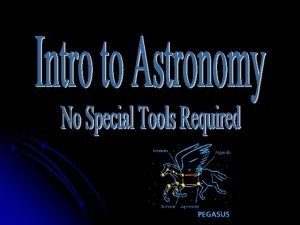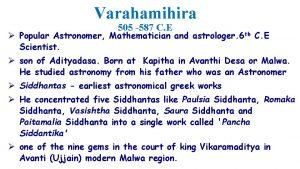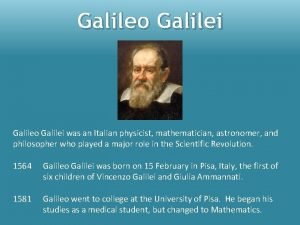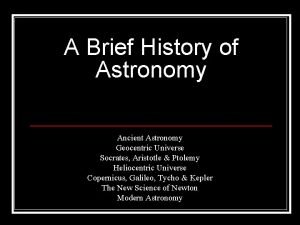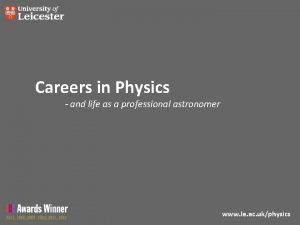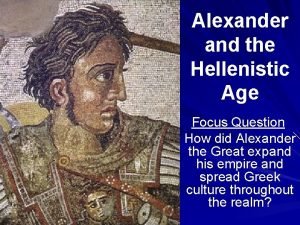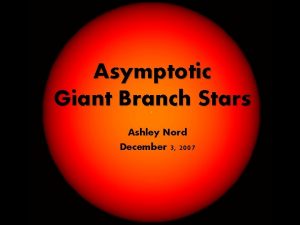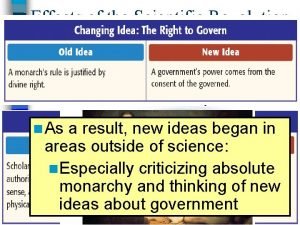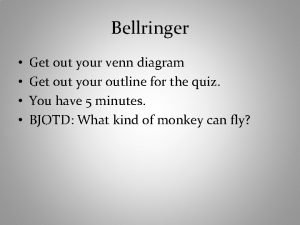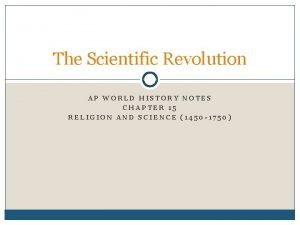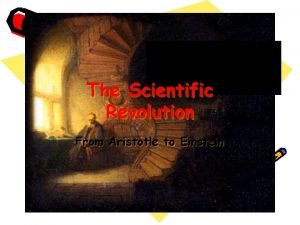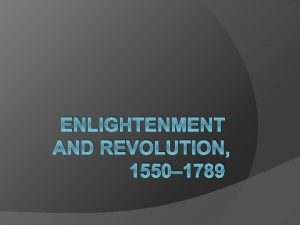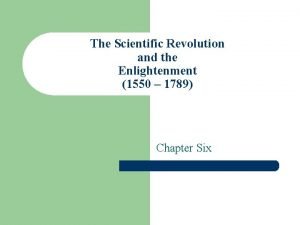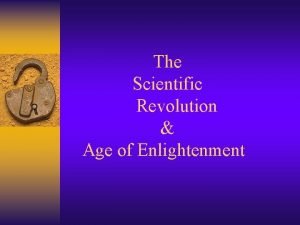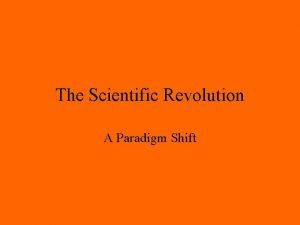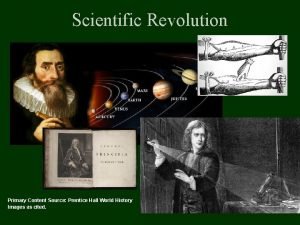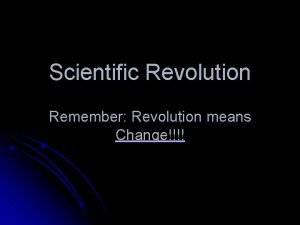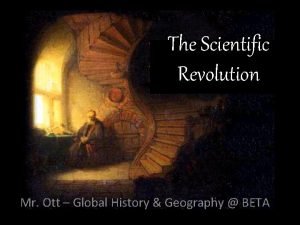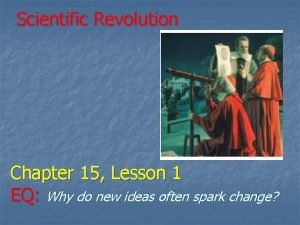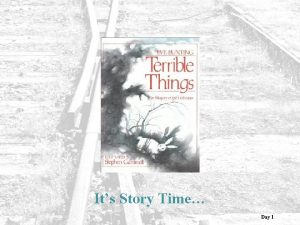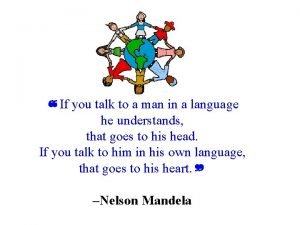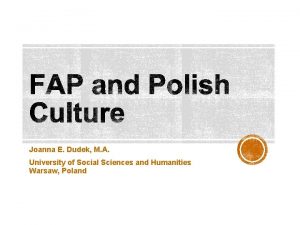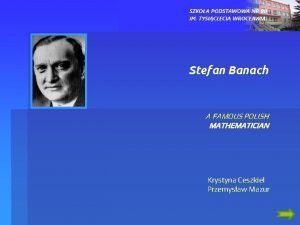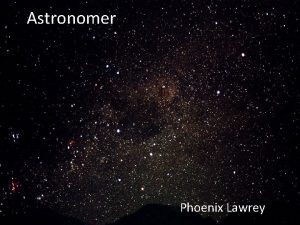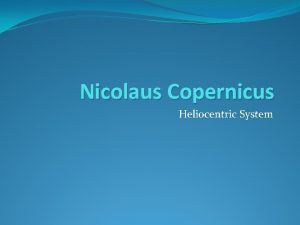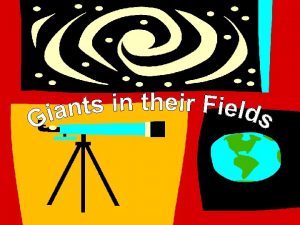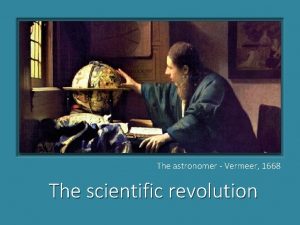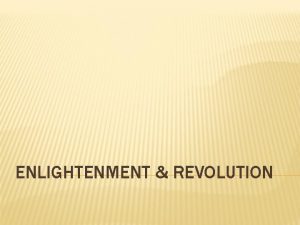THE SCIENTIFIC REVOLUTION The Scientific Revolution Polish astronomer










































- Slides: 42

THE SCIENTIFIC REVOLUTION

The Scientific Revolution • Polish astronomer Nicolas Copernicus uses mathematical calculations to revise the model of the universe from an earth-centered (geocentric) to a suncentered (heliocentric) one. • Johannes Kepler determines that the planes have an elliptical orbits rather than circular. Both challenged the Aristotelian idea of the fixed universe and the Christian belief in the central place of the earth. • Galileo Galilei further provokes the Church by demonstrating the existence of gravity, using a telescope to prove the heliocentric model, and publishing a tract critical of traditional astronomical theories.

The Empirical Method • Sir Francis Bacon publishes his Novum Organum in an effort to compel scientists to free themselves from erroneous thinking. • • His method empiricism, which uses direct observation of nature and experimentation to reach conclusions. The empirical method also involves tabulation of facts and record keeping.

Rene Descartes • Unlike Bacon, he follows the deductive process of reasoning because he feels that the senses are deceptive. • Discourse on Method begins by calling all knowledge into question • • His first premise is that “Cogito, ergo sum”… I think therefore I am or if I am being deceived, then surely "I" must exist! He gives precedence to the rational faculties, effectively separating the body from the mind.

Newtonian Physics • Sir Isaac Newton initiates the science of modern physics with the publication of Principia Mathematica. The universe is ordered and intelligible. Mathematical equations are used to explain the motions of the stars, planets and earthly matter. • Three Laws of Motion. Law of Inertia An applied force, F, on an object equals the time rate of change of its momentum, p. Newton's Third Law states that for every action there is an equal and opposite reaction.

The Age of Enlightenment

Enlightenment Ideals �The supreme quality of the Enlightenment is its reliance on reason �Enlightenment thinkers argue that through using their reason to harness nature and solve problems, humans will better themselves and civilization will progress �Like the physical world, human nature can be understood and enhanced by discovering its natural laws �The belief in laws of nature proves claims that certain rights, life, liberty, and property, are “natural” or indisputable

The Philosophes � Middle class and upper class thinkers, scientists, and artists who gather in French salons to discuss ideas become known as the philosophes � These salons are often organized by well-born women who were interested in advancing gender equality � The philosophes championed three ideas: 1. Confidence in progress and rational inquiry 2. Belief in a Deist religion (God as an impersonal ‘watchmaker’ who set the universe in motion) 3. Promotion of intellectual and religious tolerance � Denis Diderot edits the thirty-five-volume Encyclopédie, which includes most of the knowledge of the day

Deism �Deism is the belief in the existence of a God or supreme being but a denial of revealed religion, basing one’s belief on the light of nature and reason. �Deists saw no point in any particular religion; they recognized only a distant God, uninvolved in the daily life of man.

Pantheism �Pantheism is the belief that God and nature are one and the same. �Gradually, highly educated Protestants & Catholics thought more about God’s work as revealed through science, rather than through the Scriptures.

Social Contract Theory �A government is legitimate if people would voluntarily submit to its authority �Central idea: government (and its authority) are rational

Social Contract Theory �Imagine two situations: Government (the state) No government (the state of nature) �Which would you choose?

Thomas Hobbes (1588 -1679) • All general rights follow from a right to liberty • Others shouldn’t interfere with me • Others shouldn’t interfere with my doing what I want to do

Thomas Hobbes • You would choose government • Life in the state of nature would be “solitary, poor, nasty, brutish, and short”

Hobbes’s state of nature • Equality of ability —> • Equality of hope —> • Conflict (most goods are private) —> • War —> • Poverty • To escape this, we’d agree to a government

Hobbes’s Social Contract �You would give up LIBERTY �To gain SECURITY

Hobbes on Liberty and Rights �You have a general right to liberty �Liberty = the absence of external impediments �Your right is natural, independent of government �A right is a liberty to do or forebear �This is weaker than a general right �There are no positive rights

Hobbes’s laws of nature �Natural law tradition: laws of nature are God- given laws ordering the universe �Hobbes: laws of nature are rational principles of conduct

Hobbes’s laws of nature �Key laws Seek peace Defend yourself Surrender some liberty for peace, keeping only as much as you will allow others against yourself

John Locke • Rationality justifies government • But also limits authority

Locke’s state of nature �Equality of power and jurisdiction �Liberty, not license �Law of nature: no one ought to harm another is his life, health, liberty, or possessions

Locke’s state of nature �You have natural rights in the state of nature: Rights to life, health, liberty, and property Right of self-preservation Right to execute the law of nature �Not a state of war

Locke’s Social Contract • Problem: who shall be judge? • You would give up • Your right to execute the law of nature • You gain • Impartial judgment

Natural and social rights �Rights to life, health, liberty, and property are natural— you have them in the state of nature �You do not give them up in the social contract �You can’t give them up �Slavery would be wrong even if voluntary

The Baron de Montesquieu • He identified three kinds of government: • Republics • Despotism • Monarchies • He argued that the government functioned through a separation of powers controlled by checks and balances.

Denis Diderot • Encyclopedia or Classified Dictionary of the Sciences, Arts, and Trades. • • 28 volume collection of knowledge published to change the general way of thinking. Many of its articles attacked old French society an argued for religious toleration and social improvements to make society more humane.

Adam Smith • The Wealth of Nations. • The government had only three legitimate functions: Protecting society from invasion (army) • Defending citizens from injustice • Maintaining publics works • • Laissez-Faire • a policy or attitude of letting things take their own course, without interfering.

Mary Wollstonecraft 1759 -1797 �Writes The Vindication of the Rights of Woman (1792) �Condemns the stereotypical view of women as weak, intellectually inferior, and docile �Advocates for a ‘revolution of female manners’ which would give women education and improve them morally

Immanuel Kant 1724 -1804 �Writes Critique of Practical Reason in 1788 �Argues that ethical behavior should be guided by the “Categorical Imperative, ” in which an individual must always bear in mind what would happen if all people acted as he or she does �The individual’s experience is expanded to embrace universal conditions of right and wrong �Bases his morality on rational understanding rather than love

Jean-Jacques Rousseau 1712 -1778 �Writes the Social Contract and Émile (1762) �Advances the idea of the “noble savage, ” the pre-civilized man who acts in accordance to his better nature �Argues that those who belong to the state should submit to the common good for which it is created �In Émile, he turns his attention to education, asserting that the young person should be able to learn through direct experience of the world and allow his natural inclinations to lead him

The American and French Revolutions � Two revolutions ignited by Enlightenment beliefs in justice and liberty � In France two major issues were: 1. the gross inequalities between the very rich and the lower and middle classes 2. Financial crises brought on by extravagant spending by the royalty for wars and for elaborate palaces, like Versailles

Enlightenment Literature �Alexander Pope (1688 -1744) wrote Essay on Man in which he proclaims the optimistic, deist belief that everything has a plan �Journalistic essays, written for growing audience of periodical, broadsheet, and newspaper readers, becomes popular prose -style form that shapes opinions and dispenses political beliefs �Novels, such as Daniel Defoe’s Robinson Crusoe entertain with graphic tales of adventure and realistic details

Jonathan Swift and Voltaire �Two masters of satire, Swift and Voltaire had varying objects of their attacks �An Irish-man who was aware of the injustices faced by his countrymen, Swift had a low opinion of humanity �His Gulliver’s Travels (1726) creates fantastical worlds. He uses these societies to comment upon human folly and corruption �Inspired by Swift, Voltaire condemns organized religion and fanaticism in his satirical works. His book Candide (1759) makes fun of the “best of all possible worlds” type of optimism of Leibniz

The Rococo • A style that begins in • • ornamented interiors of Versailles and the salons of upper middle class French Features pastel colors, gilding, and decorative floral ‘wedding cake’ Becomes popular in courts and in German and Austrian churches, like this one in Bavaria

• Portray indulgences in sensual pleasure and elegant leisure activities, often in pastoral environments • Subjects inspired Greek mythology • François Boucher was director of the Royal Academy of Art and the first painter to Louis XV

Neoclassicism �Attempt to revive Greco-roman art �Archeological discoveries of Herculaneum and Pompeii lead to fresh encounter with the classical aesthetic �Extols balance, simplicity, and clarity �Becomes associated with the French Revolution in opposition to ‘decadent’ rococo style �Upon becoming emperor of France in 1804, Napoleon Bonaparte orders the reconstruction of Paris to imitate the grandeur of Imperial Rome

Neoclassical Architecture, The Arc de Triumph • Modeled on the • • triumphal arches of the Romans Centered at the meeting of twelve avenues 164 feet tall Built from 1806 -1836 Commemorates Napoleon’s armies

Jacques-Louis David • The Death of Socrates, oil on canvas, 1787 • Pictures the philosopher as a heroic figure, boldly meeting his death • Acts as a call to duty and self-control in the midst of chaos

Classical Music �Style of music written between 1760 -1820 �Performed in courts and public theatres �Features balance, restraint, symmetry �Still uses three movement, fast/slow/fast, of Baroque music �Melodies are easy to hear and are repeated and developed throughout the piece to provide artistic unity �The transitions between loud and soft or fast and slow happen gradually rather than immediately

Classical Music continued � Several types of instrumental groupings are used: 1. Symphony, a piece for a full orchestra 2. Concerto, a piece with one or more solo instrument and an orchestra 3. String quartet, a piece for four string instruments (2 violins, a viola, cello) 4. Sonata, a piece for a keyboard instrument by itself or another instrument with a keyboard instrument 5. The three part sonata form is the type of form used for the first and last movements of a piece

Franz Joseph Haydn 1732 -1809 • Austrian classical composer who writes 104 symphonies and 84 string quartets, which were two forms which he helped to create • He composed his last 12 symphonies in London • One of these No. 94, is nicknamed “The Surprise Symphony” because of the jolting fortissimo (very loud) crash on a weak beat in the second movement • Folk melodies provide basis for some of these symphonies

Wolfgang Amadeus Mozart 1756 -1791 • A child prodigy, Mozart becomes one of the most wellknown composers of all time • He created 650 works, including symphonies, operas, sonatas, concertos, and string quartets • He used popular melodies in many of his symphonies, like Number 40, written in 1788 • His operas, Don Giovanni, The Magic Flute, The Marriage of Figaro, and Cosi Fan Tutte contain memorable, life-like characters and emotional scenes
 Normal polish notation java
Normal polish notation java Polish notation
Polish notation Astronomy vs astrology definition
Astronomy vs astrology definition Varahamihira information
Varahamihira information Italian physicist mathematician astronomer and philosopher
Italian physicist mathematician astronomer and philosopher Galileo definition
Galileo definition Astronomer salary per month
Astronomer salary per month Astronomer in the hellenistic age
Astronomer in the hellenistic age Ashley astronomer middle ground
Ashley astronomer middle ground Russian revolution vs french revolution
Russian revolution vs french revolution Did american revolution cause french revolution
Did american revolution cause french revolution Third agricultural revolution definition
Third agricultural revolution definition Effects of scientific revolution
Effects of scientific revolution Scientific revolution and enlightenment speed dating
Scientific revolution and enlightenment speed dating Scientific revolution ap world history
Scientific revolution ap world history Newton's first law of motion
Newton's first law of motion Enlightenment vs scientific revolution
Enlightenment vs scientific revolution How did the reformation help spur the scientific revolution
How did the reformation help spur the scientific revolution What did isaac newton do in the scientific revolution
What did isaac newton do in the scientific revolution Jupiter's moons
Jupiter's moons Newton's first law of motion
Newton's first law of motion Causes of scientific revolution
Causes of scientific revolution Scientific revolution and enlightenment speed dating
Scientific revolution and enlightenment speed dating Scientific revolution effects
Scientific revolution effects Scientific revolution primary sources
Scientific revolution primary sources Causes of scientific revolution
Causes of scientific revolution Whats the scientific revolution
Whats the scientific revolution Chapter 6 the scientific revolution
Chapter 6 the scientific revolution Scientific revolution effects on society
Scientific revolution effects on society Lesson 1 the scientific revolution answer key
Lesson 1 the scientific revolution answer key How is a scientific law different from a scientific theory?
How is a scientific law different from a scientific theory? Scientific inquiry vs scientific method
Scientific inquiry vs scientific method Polish urban legends
Polish urban legends Polish bank association
Polish bank association Hitler's first photograph
Hitler's first photograph Polish pork chops
Polish pork chops Polish beetle tongue twister
Polish beetle tongue twister Dudek joanna
Dudek joanna Baptism of piland
Baptism of piland Polish san bernardino escorts
Polish san bernardino escorts Polish eating habits
Polish eating habits Polish leasing association
Polish leasing association Famous polish mathematicians
Famous polish mathematicians


